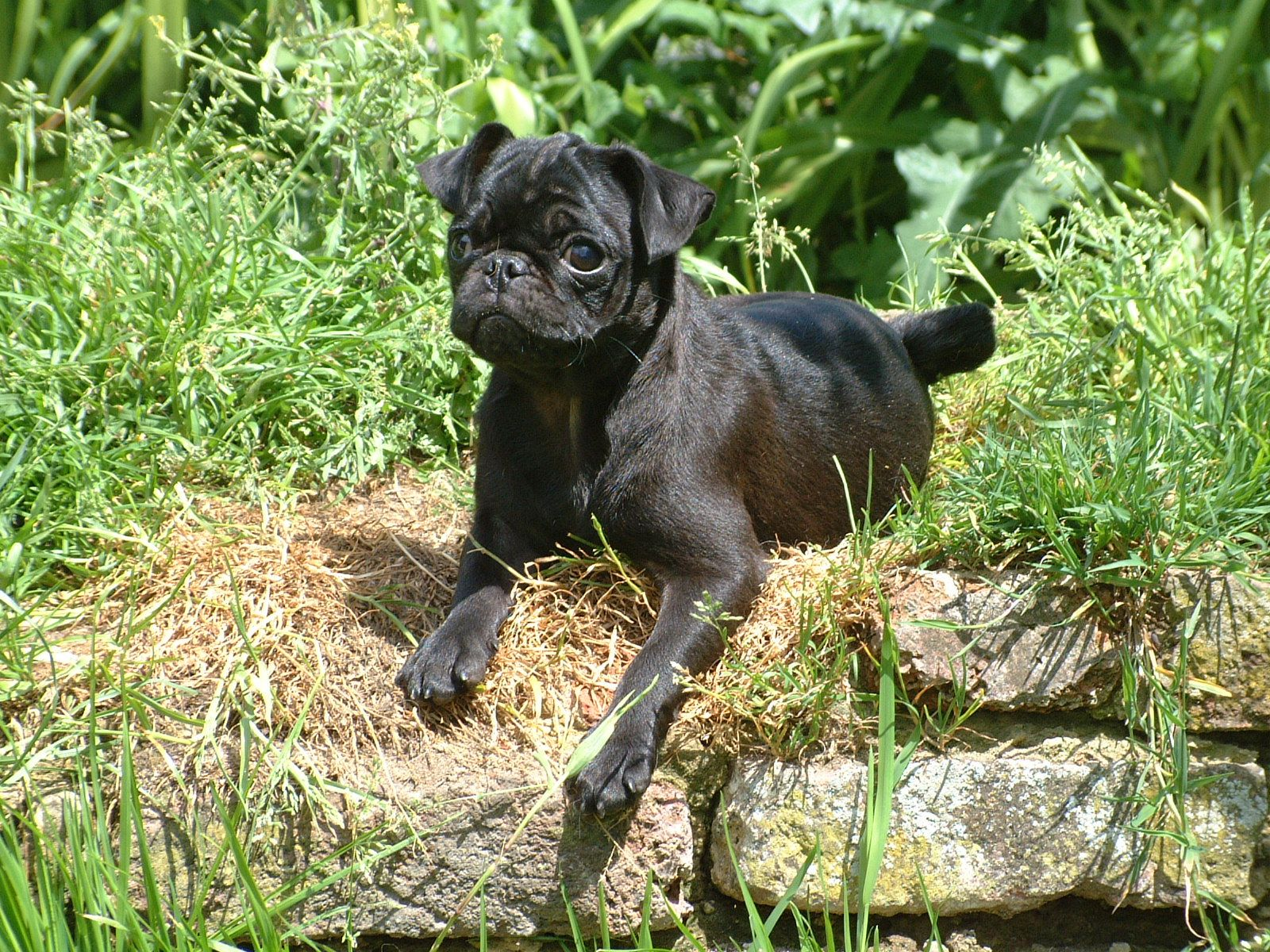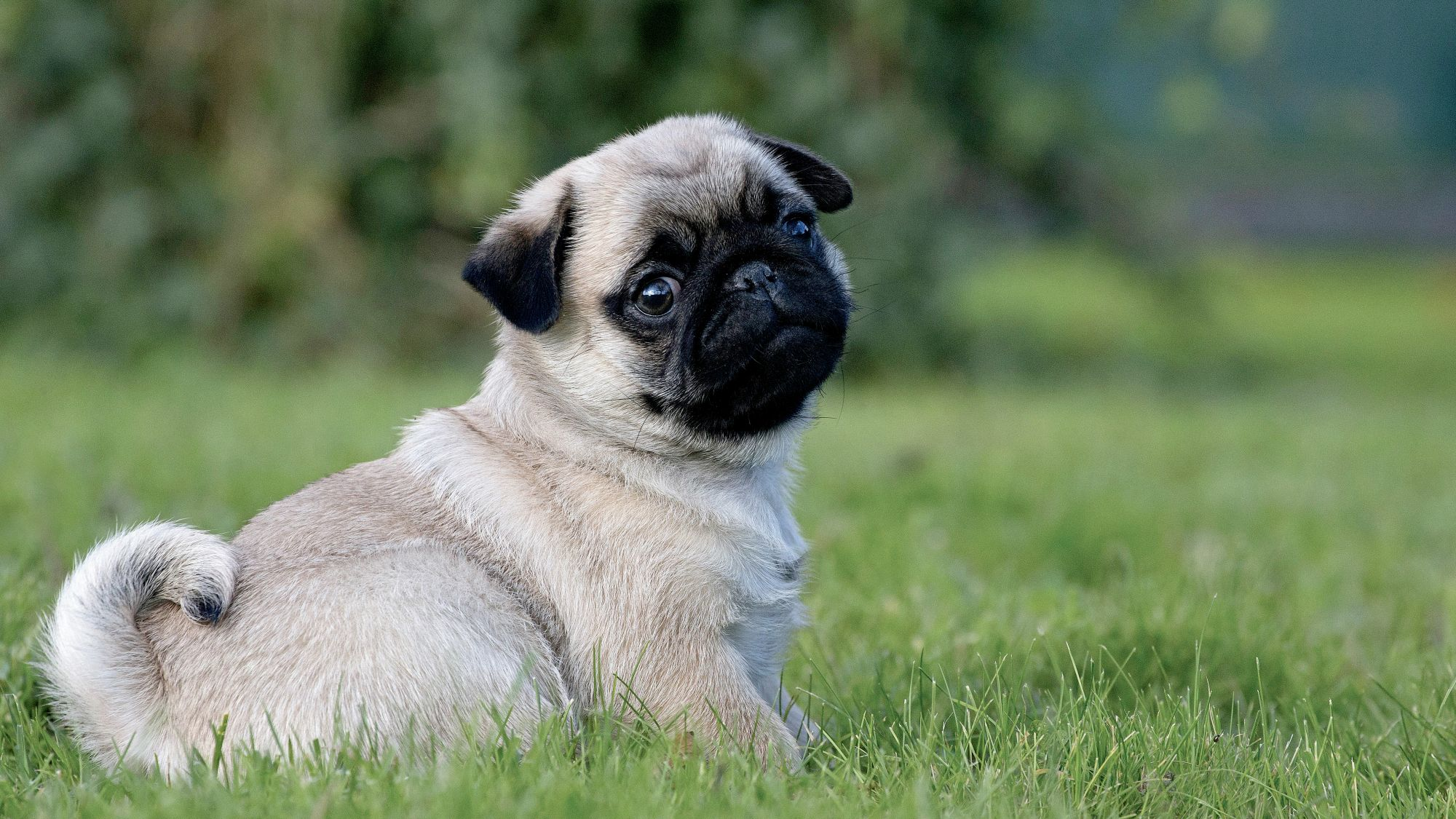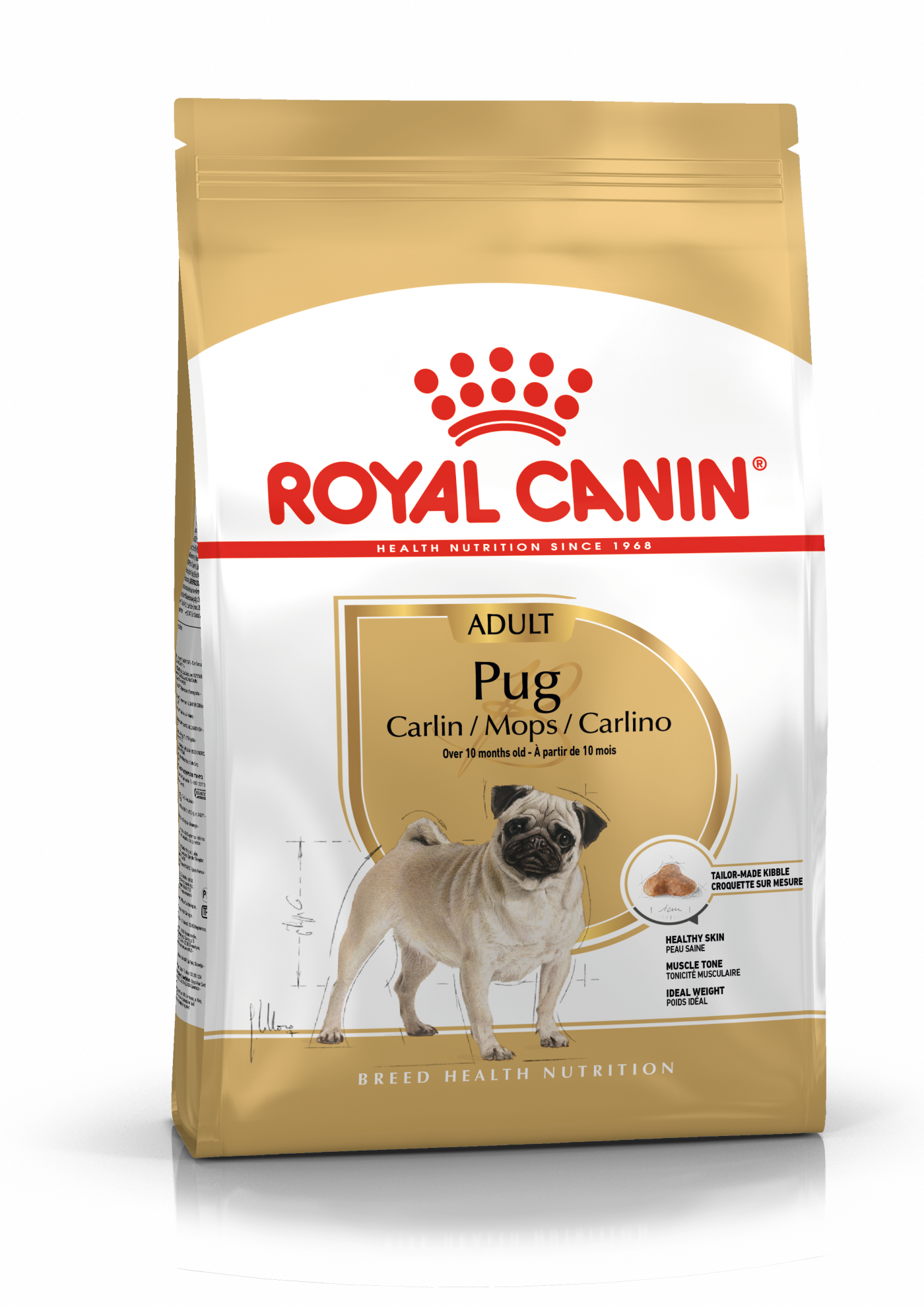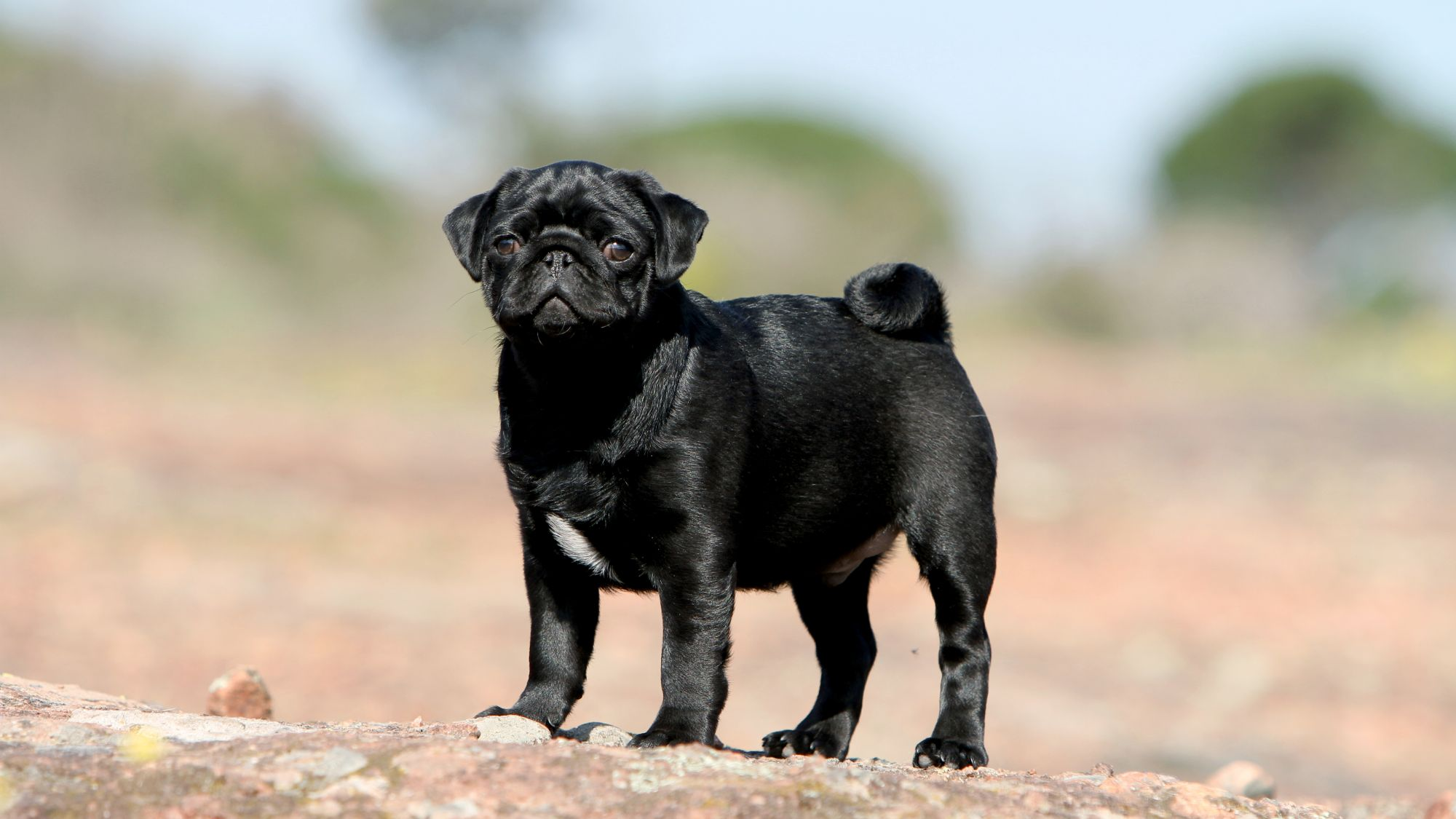Pug - Breed Facts & Characteristics
A popular member of the toy group of breeds, the Pug is a barrel-shaped bundle of canine fun. With their unique appearance, they’re always the star of the show, and they have a sweet-natured, playful disposition too. They also have an easy coat to maintain, don’t require tons of exercise and they’re not a breed that barks very much either. The Pug even has its own Latin motto, “Multum in Parvo”, which translates as: “A lot in a little.”
Official name: Pug
Other names: Pug Dog, Chinese Pug
Origins: China
Drooling tendencies
{score 0 out of 5}Grooming needs
{score 0 out of 5}Shedding Level
{score 0 out of 5}Barking tendencies
{score 0 out of 5}Energy level
{score 0 out of 5}Compatibility with other pets
{score 0 out of 5}Warm weather
{score 0 out of 5}Cold weather
{score 0 out of 5}Suited to apartment living
{score 0 out of 5}Can stay alone
{score 0 out of 5}Family pet
{score 0 out of 5}
| Male | Female |
|---|---|
| Height | Height |
| 25.5 - 33 | 25.5 - 33 |
| Weight | Weight |
| 6.3 - 8.1 | 6.3 - 8.1 |
| Puppy | Adult |
|---|---|
| 2 to 10 months | 10 months to 8 years |
| Mature | Senior |
| 8 to 12 years | Over 12 |
| Baby | |
| Birth to 2 months | |
Drooling tendencies
{score 0 out of 5}Grooming needs
{score 0 out of 5}Shedding Level
{score 0 out of 5}Barking tendencies
{score 0 out of 5}Energy level
{score 0 out of 5}Compatibility with other pets
{score 0 out of 5}Warm weather
{score 0 out of 5}Cold weather
{score 0 out of 5}Suited to apartment living
{score 0 out of 5}Can stay alone
{score 0 out of 5}Family pet
{score 0 out of 5}
| Male | Female |
|---|---|
| Height | Height |
| 25.5 - 33 | 25.5 - 33 |
| Weight | Weight |
| 6.3 - 8.1 | 6.3 - 8.1 |
| Puppy | Adult |
|---|---|
| 2 to 10 months | 10 months to 8 years |
| Mature | Senior |
| 8 to 12 years | Over 12 |
| Baby | |
| Birth to 2 months | |
Tailored nutrition for your Pug

Get to know the Pug
All you need to know about the breed
Cute, quirky and characterful, the Pug looks almost like a real-life ‘Baby Yoda’. Very in-demand, especially with families, they are renowned for their even-tempered, docile disposition. They’re great with children and other pets, once trained – especially as they have a playful side to their personality – and Pugs are quite smart little dogs, too.
They also have the advantage of being a fairly low-maintenance breed. Their short, smooth coat makes them easy to care for and they require only a moderate amount of exercise. A fairly quiet breed, too, the Pug doesn’t tend to bark that much.
A favourite of dog-lovers for a mere 2,000 years, the Pug was originally bred in China, where snub-nosed dogs have always been in vogue. Brought over to Europe in the 16th century, they have been a popular pet dog, on both sides of the world, ever since.
A member of the toy group of dogs, the Pug is unique in being the only member to share their ancestry with the Mastiff. Notably, both breeds have the same wrinkly features in common.
Small but solid, Pugs have a soft, smooth coat that comes in a range of colours – from silver and apricot to fawn and black. They also have a particularly expressive face. Known for their barrel-shaped body, too, the silhouette is completed by their distinctive curled tail.
One thing to bear in mind is that their squat stature and couch-potato tendencies can make Pugs prone to putting on weight. But no need to worry; as long as they have the right diet and enough exercise, it’s not hard to keep your Pug at their peak. On that note, with an average life expectancy of 12 to 15 years, the Pug has a pretty good lifespan too.
A popular fixture in film and television, the Pug dog breed often pops up on our screens. Perhaps most notably, the Men in Black franchise features Frank – a fictional talking Pug. Also, in the TV series Spin City, Carter’s pet Pug, Rags, frequently steals the show – and a Pug called Bess also appears in The West Wing. Stars one and all!

2 facts about Pugs
1. Not to be sneezed at
If they get over-excited, Pugs are prone to what is known as ‘reverse sneezing’, causing them to gasp and snort. However, this is not usually harmful, and massaging the throat and calming them with soothing words can help to shorten an episode.
2. The French connection
Joséphine Bonaparte, wife of Napoleon, was herself a fan of the Pug dog breed and had her own dog called ‘Fortune’. What is more, when she was imprisoned in Paris, she smuggled out messages by hiding them under her dog’s collar. For more facts on the history of the Pug, see below…
History of the breed
Believed to date back at least 2,000 years – and quite possibly longer – the Pug is one of our most ancient dog breeds. They also have an illustrious canine heritage. The Pug population was given a further boost in England with the storming of the Imperial Palace in Beijing in 1860.
When the British returned home, they brought with them some of the dogs they had found there. The breed subsequently found fame in the US, as well, and the Pug was recognised by the American Kennel Club in 1885. More recently, the breed has continued to gain in popularity and the Pug is now among the most coveted of the toy varieties.
From head to tail
Physical characteristics of Pugs
1.Head
2.Muzzle
3.Body
4.Fur
5.Tail

Things to look out for
From specific breed traits to a general health overview, here are some interesting facts about your Pug
They can be prone to respiratory issues
The Pug is what is known as a ‘brachycephalic’ breed, which means they can be susceptible to breathing difficulties because of the shape of their head, muzzle and throat. Other examples of this include the French and English Bulldogs, the Pekingese and the Boston Terrier. In the case of the Pug, their breathing passage ways are particularly compact. This also means that Pugs don’t do well in hot weather, and can be prone to heatstroke, so their walks should be timed accordingly. As always with these things, prevention is better than cure, so it’s important to buy from a responsible breeder who will be aiming for the healthiest dogs possible.
Eye problems can be another area of concern
The large, globe-shaped eyes of the Pug are one of their best-loved features. But they can also be prone to a few potential problems. Among these are cataracts, corneal ulcers and eyelid/eyelash disorders as well as a condition called pigmentary keratopathy that is common in brachycephalic dogs. As early detection can often help to head off more serious issues, it’s a good idea to check their eyes regularly for any warning signs. Your Pug’s weekly grooming sessions can be a good moment for this. Also, regular optical examinations can be booked in with your vet for long-term peace of mind.
It’s best to leave breeding to the professionals
One of the lesser-known issues that could affect your Pug – and only if they are a female – is a condition called ‘dystocia’. Essentially, this is a difficulty in giving birth, and it means that Pugs can often require a Caesarean to ensure the safe delivery of their puppies. As this can be dangerous for your dog, having your Pug spayed is highly recommended. In any event, it’s best to leave breeding to the professionals who know how to ensure the safety of both the mother and her puppies. Responsible breeders will also screen for various hereditary conditions and breed selectively to make sure their features don’t become too exaggerated.
Healthy diet, healthier dog

When choosing food for a Pug, there are many factors to consider: their age, lifestyle, activity level, physiological condition, and health including potential sickness or sensitivities. Food provides energy to cover a dog’s vital functions, and a complete nutritional formula should contain an adjusted balance of nutrients to avoid any deficiency or excess in their diet, both of which could have adverse effects on the dog. Clean and fresh water should be available at all times to support your dog’s urinary health. In hot weather and especially when out exercising, bring water along for your dog’s frequent water breaks. The following recommendations are for healthy animals. If your dog has health problems, please consult your veterinarian who will prescribe an exclusive veterinary diet.
A Pug puppy’s requirements, in terms of energy, protein, minerals and vitamins, are much greater than those of an adult dog. They need energy and nutrients to maintain their body, but also to grow and build it. Until they are 10 months old, a Pug puppy's immune system develops gradually. A complex of antioxidants - including vitamin E - can help support their natural defences during this time of big changes, discoveries, and new encounters. Their digestive functions are different from an adult Pug’s, too: their digestive system is not mature yet so it’s important to provide highly digestible proteins that will be effectively used. Prebiotics such as fructo-oligosaccharides (FOS), support digestive health by helping balance the intestinal flora, resulting in good stool quality.
The brachycephalic nature of the Pug is an important factor that needs to be taken into account when choosing the size, shape, and texture of a kibble to make it easier for them to pick up and to encourage chewing. This intense growth phase also means high energy needs, so the food must have a high energy content (expressed in Kcal/100g of food), while concentrations of all other nutrients will also be higher than normal in a specially formulated growth food. It is recommended to split the daily allowance into three meals until they are six months old, then to switch to two meals per day.
Throughout their life, it is important to avoid feeding them human foods or fatty snacks. Instead, reward your dog with kibble taken from their meal allowance, and strictly follow the feeding guidelines written on the package in order to prevent excessive weight gain.
At adult age, small breed dogs are exposed to oral and dental disorders, more precisely accumulation of dental plaque and tartar. The Pug’s teeth and jaws need a lot of protection. A formula containing calcium chelators will help reduce tartar formation, helping to support daily oral hygiene. The shape and size of the kibble should be designed to make it easier for your brachycephalic dog to pick up, and the texture should encourage them to chew before swallowing.
Small breed dogs are well known for being fussy eaters. Exclusive formula and flavourings, as well as a kibble size with a special texture, will stimulate their appetite. Small breed dogs are prone to urinary stones; a diet that supports a healthy urinary system is recommended.
For Pugs living mainly indoors, highly digestible proteins, an appropriate fibre content, and very high-quality carbohydrate sources will help reduce faecal smell and amount. Because an indoor lifestyle often means less exercise, an adapted calorie content, which meets the reduced energy needs, and a diet that contains L-carnitine, which promotes healthy fat metabolism, can help maintain an ideal weight. Note that apart from an indoor lifestyle, neutering is also a factor in overweight dogs.

The main nutritional goals for adult Pugs are:
Maintaining healthy skin by supporting the skin barrier with the enriched addition of essential fatty acids (especially EPA-DHA), essential amino acids, and B vitamins
Maintaining muscle tone with an adjusted protein content and antioxidants
Maintaining an ideal body weight by using highly digestible ingredients and keeping the fat content at a sensible level.
At adult age, small breed dogs are exposed to oral and dental disorders, more precisely accumulation of dental plaque and tartar. The Pug’s teeth and jaws need a lot of protection. A formula containing calcium chelators will help reduce tartar formation, helping to support daily oral hygiene. The shape and size of the kibble should be designed to make it easier for your brachycephalic dog to pick up, and the texture should encourage them to chew before swallowing. Small breed dogs are well known for being fussy eaters. Exclusive formula and flavourings, as well as a kibble size with a special texture, will stimulate their appetite. Small breed dogs are prone to urinary stones; a diet that supports a healthy urinary system is recommended. For Pugs living mainly indoors, highly digestible proteins, an appropriate fibre content, and very high-quality carbohydrate sources will help reduce faecal smell and amount. Because an indoor lifestyle often means less exercise, an adapted calorie content, which meets the reduced energy needs, and a diet that contains L-carnitine, which promotes healthy fat metabolism, can help maintain an ideal weight. Note that apart from an indoor lifestyle, neutering is also a factor in overweight dogs.

After 8 years old, Pugs start facing the first signs of ageing. A formula enriched with antioxidants will help maintain their vitality and an adapted phosphorus content will support their renal system. Ageing is also accompanied by the modification of digestive capacities and particular nutritional requirements, so food for older Pugs should have the following characteristics:
Higher vitamin C and E content. These nutrients have antioxidant properties, helping to support the body’s cells against the harmful effects of the oxidative stress linked to ageing.
A high-quality protein. Contrary to a widely held misconception, lowering the protein content in food brings little benefit in limiting kidney failure. In addition, older dogs are
less efficient at using dietary protein than younger dogs. Reducing the phosphorus content is a good way of slowing down the gradual deterioration of kidney function
A higher proportion of the trace elements iron, zinc, and manganese to help maintain good condition of the skin and coat
A higher quantity of polyunsaturated fatty acids (omega-3 and omega-6 fatty acids) to maintain the quality of the coat. Dogs can normally produce these fatty acids, but ageing
can affect this physiological process
As they age, dogs increasingly suffer from teeth problems. To ensure they continue to eat in sufficient quantities, the size, shape, and texture of their kibble needs to be tailored
to their jaw.

Caring for your Pug
Grooming, training and exercise tips
As this is a breed that likes nothing better than cosying up with their owners on the sofa, and they also adore their food, it’s important that Pugs are exercised every day. Up to an hour should do the trick, either through walking or at the dog park, and they enjoy playing games in the garden too.
One thing to remember is that Pugs are less suited to running, however, as this may cause them to hyperventilate. Also, in hot weather, it’s best to take them out early or late in the day to avoid the midday sun. As they generally can’t swim, water should be avoided as well.
One of the many benefits of having a Pug is the minimum grooming required. Their short, smooth coats almost look after themselves, really. All they will need is a gentle weekly once-over with a medium-bristled brush or a grooming mitt. Pugs won’t even need bathing unless they’ve been rolling in any mud. Just one word of warning: Pugs can moult rather a lot during the shedding season so will need extra brushing then to remove any dead hair. Nails should be kept short with regular clipping and ears and eyes checked for anything out of the ordinary. Lastly, frequent teeth-brushing is important, as are periodic dental check-ups.
While it’s true that the Pug is the perfect companion animal, these little lapdogs can be a tiny bit stubborn at times – especially when it comes to house training. Pugs will benefit, therefore, from early learning at puppy-training classes. Once they get the hang of things, they are quite intelligent animals and learn quickly. They will also benefit from the early socialisation that the classes bring. It’s always best to use reward-based training and positive reinforcement, as Pugs can be quite sensitive and thrive on encouragement and praise. Later, Pugs can go on to do well at activities such as obedience.
As this is a breed that likes nothing better than cosying up with their owners on the sofa, and they also adore their food, it’s important that Pugs are exercised every day. Up to an hour should do the trick, either through walking or at the dog park, and they enjoy playing games in the garden too.
One thing to remember is that Pugs are less suited to running, however, as this may cause them to hyperventilate. Also, in hot weather, it’s best to take them out early or late in the day to avoid the midday sun. As they generally can’t swim, water should be avoided as well.
One of the many benefits of having a Pug is the minimum grooming required. Their short, smooth coats almost look after themselves, really. All they will need is a gentle weekly once-over with a medium-bristled brush or a grooming mitt. Pugs won’t even need bathing unless they’ve been rolling in any mud. Just one word of warning: Pugs can moult rather a lot during the shedding season so will need extra brushing then to remove any dead hair. Nails should be kept short with regular clipping and ears and eyes checked for anything out of the ordinary. Lastly, frequent teeth-brushing is important, as are periodic dental check-ups.
While it’s true that the Pug is the perfect companion animal, these little lapdogs can be a tiny bit stubborn at times – especially when it comes to house training. Pugs will benefit, therefore, from early learning at puppy-training classes. Once they get the hang of things, they are quite intelligent animals and learn quickly. They will also benefit from the early socialisation that the classes bring. It’s always best to use reward-based training and positive reinforcement, as Pugs can be quite sensitive and thrive on encouragement and praise. Later, Pugs can go on to do well at activities such as obedience.
7/7
All about Pugs
No, of all the different dog breeds you could choose, Pugs are probably one of the easiest. As well as their easy-going personalities, their short coats are super-easy to care for. Also, due to their small size and not being an especially high-energy breed, Pugs only require a moderate amount of exercise.
Yes, Pugs make an excellent choice for families as they are playful and affectionate. As with any dog, training is essential, with kids if possible. Also, because of their very specific mouth shape, they are not normally capable of an aggressive bite. For this reason, Pugs are considered to be an ideal dog for families.
Other breeds that might interest you
Read more on this topic
Sources
- Veterinary Centers of America https://vcahospitals.com/
- Royal Canin Dog Encyclopaedia. Ed 2010 and 2020
- Banfield Pet Hospital https://www.banfield.com/
- Royal Canin BHN Product Book
- American Kennel Club https://www.akc.org/
Like & share this page